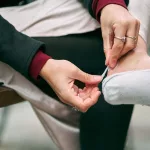Bowen therapy, often called Bowenwork or Bowtech, is a hands-on bodywork approach. It uses gentle stretches of the fascia — the connective tissue surrounding muscles and organs — with the aim of easing pain and encouraging relaxation.
A practitioner of Bowen uses precise, delicate rolling motions with their hands. These movements target muscles, tendons, ligaments, and the surrounding fascia and skin. The technique is intended to reduce pain by stimulating the nervous system.

Bowen therapy was developed by Thomas Ambrose Bowen (1916–1982) in Australia. Although Bowen had no formal medical credentials, he maintained that the method could reset the body’s pain response.
Practitioners of Bowenwork commonly assert that the therapy influences the autonomic nervous system. They propose that it dampens the sympathetic nervous system (the fight-or-flight response) and encourages the parasympathetic nervous system (the rest-and-digest response).
However, these proposed mechanisms have not been confirmed by solid research.
Some classify Bowen therapy as a form of therapeutic massage, but it is not a medical intervention. Scientific study of Bowen is limited, and most claims of benefit are anecdotal.
Despite limited evidence, many people worldwide pursue Bowen therapy for a variety of complaints.
What is Bowen therapy usually used for?
Bowen therapy is a form of myofascial release typically employed to reduce pain and enhance mobility. It’s commonly used as an adjunct or alternative approach.
Conditions commonly addressed with Bowen therapy include:
- frozen shoulder
- headaches
- migraine
- back pain
- neck pain
- knee injuries
Some individuals may turn to Bowen therapy to help manage pain stemming from:
- respiratory issues, such as asthma
- gastrointestinal problems, like irritable bowel syndrome
- side effects of cancer treatments
Others may seek Bowenwork to address:
- stress
- fatigue
- depression
- anxiety
- high blood pressure
- stiffness and limited range of motion
Does Bowen therapy work? What the evidence says
Bowen therapy has not been extensively studied, though some people report benefits from it.
Available evidence is mainly from short-term trials with notable limitations, including small sample sizes and lack of diversity. More rigorous research is necessary to validate Bowen therapy’s health effects.
A 2024 controlled trial involving 132 people with fibromyalgia compared Bowen therapy, a standard exercise regimen, craniosacral therapy, and static touch therapy over 12 weeks.
Investigators reported that Bowen therapy improved sleep quality and pressure pain threshold (the amount of pressure required before someone feels pain). These improvements were still reported 24 weeks after treatment.
A 4-week study involving 30 patients with thoracic myofascial pain syndrome gave participants one of two treatments: three weekly 15–20 minute Bowen sessions or three weekly 15-minute sessions using a tennis ball technique.
That study found Bowen therapy to be markedly more effective at reducing pain and improving function over time than the tennis ball method. The tennis ball technique is a self-treatment where a ball is positioned between the back and a wall or floor and pressure is applied to tender spots.
Another trial with 90 patients who had myofascial neck pain examined the impact of eight Bowen sessions across 12 weeks versus conventional care, with a follow-up 24 weeks after the first session to evaluate longer-term effects.
Results suggested the 45 participants who received Bowen therapy experienced significant gains compared with the control group in areas such as neck range of motion, anxiety, depressive symptoms, how much neck pain disrupted daily life, and pressure pain threshold. These benefits were still reported at 24 weeks.
While these studies indicate benefits may persist after treatment, other research suggests effects on chronic pain may be temporary.
A small trial split 31 people with chronic pain into Bowen and sham therapy groups. All subjects received six sessions across 8 weeks, with follow-ups at 1 week and 6 weeks post-treatment.
Patients in the Bowen group reported reduced pain scores at the 1-week follow-up compared with the placebo group, but no differences were seen at 6 weeks. The researchers concluded Bowen therapy might offer short-term pain relief but may not serve as a long-term solution.
Further study into Bowen therapy’s long-term outcomes is required, especially across different ages, populations, and conditions.
What happens during a Bowen therapy session?
In most U.S. states, Bowen therapists must hold a license, often through massage therapy or another regulated healthcare credential for manual tissue work.
A typical Bowen session runs about 30 minutes to an hour. Protocols vary slightly by practitioner, but you can generally expect the following:
- You’ll be asked to wear light, loose clothing and may need to partially undress to expose the areas being treated.
- The therapist will position you lying down or sitting, depending on the areas to be treated.
- The practitioner will use their fingers to perform gentle rolling motions on targeted areas, such as the neck and back, grabbing skin, fascia, and muscle between thumb and forefinger.
- They will gently stretch and move tissues. Pressure varies, and you should immediately report any discomfort.
- During the session, the therapist may periodically leave the room to allow your body to respond and integrate the changes. They typically return after 2 to 5 minutes and continue the rolling sequences.
- Movements are repeated as needed.
- You might feel mild soreness or a release of muscle tension as tissues are worked.
- Bowen therapy does not include traditional massage strokes, tapping, or similar techniques.
After treatment, the therapist may offer self-care guidance and lifestyle tips, such as increasing fluid intake. Symptoms can shift during the session, immediately afterward, or several days later.
The number of sessions required depends on factors such as:
- your specific symptoms
- their severity
- how you respond to treatment
- your overall health
The bottom line
There is limited research on Bowen therapy’s benefits, long-term outcomes, and risks. Some studies indicate it may aid pain relief and mobility, but further research is needed to apply findings across broader age groups and populations.
If you opt for Bowen therapy, choose a licensed practitioner and discuss possible side effects and expectations before beginning treatment.


















Leave a Reply
You must be logged in to post a comment.